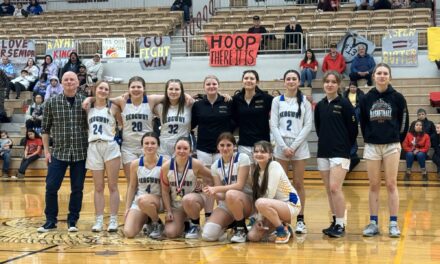It was a sold out event Saturday night in Klukwan with locals feasting on moose and salmon, and bidding on a variety of items in a live auction. The proceeds from the annual fundraiser will go toward the completion of the Jilkaat Kwaan Heritage Center. The center is set to open, at least partially, this spring.
Over the past year, around $2 million has come in toward the completion of the center. Grants, loans and private donations from fundraising efforts make up the money raised so far. As a result, the center is now just months away from opening.
Saturday night was the 10th-annual crusade, with 100 tickets sold at $50 a pop. But the big money came in during the auction. Smoked salmon, jams, artwork, traditional clothing and books were all sold off to bring in more cash for the cause.
Project director Lani Hotch told the crowd that with some new income sources, the center should be able to open its doors in 2016 – even if the massive multi-million-dollar- project is not completely done.
“And even if none of that other money comes through, we’ll still be able to open our doors this spring,” she said.
She said being this close to opening is a huge relief since she feels like she’s been working on this her whole adult life.
“When I was just a young adult, the idea first surfaced and they got a grant, I think, from the National Endowment for the Arts back in the late ‘70s.”
Over the last 12 months, the center has received grants large and small. That includes a recent one from the Surdna Foundation which helped pay for commissioned artwork for the cultural landscape map. Hotch called the map, the “grounding exhibit.”
“It’ll be the first thing you see when you walk into the exhibit hall,” Hotch explained. “And we’ve got five artists lined up so far – one is still pending.”
Hotch said the purpose of the map is to introduce visitors to the Chilkat people and their ancestral lands.
The heritage center has been in the works, even just as a concept, for decades. Years ago, art dealers and collectors trying to remove and sell artifacts from the area sparked concern, and a local law prohibiting the removal of tribal relics. It was around then, more than 20 years ago, that Klukwan residents decided they needed a safe place to display these precious pieces and show off their cultural history on their terms.
“It just got to the point where people drew a line in the sand and said ‘that’s it. We don’t want anything more to leave.’”
Money from the Institute of Museum and Library Services will go toward the installation of various pieces and exhibits. An award from the National Park Service is helping to pay carvers who are adzing the interior of the clan house where the famous Whale House Collection will live. The collection, which features four intricately-carved house posts, a feasting dish and a screen, is on loan to the heritage center.
“We’re pretty much going to install it the way it was situated in historic photos, so not a whole lot of design needs to go into that,” Hotch said.
Hotch told the crowd that the center received $1.1 million from an unexpected source: The Bureau of Indian Affairs’ tribal transportation fund. That fund is used to pay for roads or trails that incorporate a visitor’s center. But it can also go toward creating and upgrading the buildings themselves.
The Rasmuson Foundation also granted $750,000 which allowed a contract to be finalized with Dawson Construction.
“So, they are mobilizing right now,” she said. “Things are starting to happen and it’s so exciting.”
A $350,000 loan from the U.S. Department of Agriculture’s rural development loan program is still pending, but if it goes through, the money will pay for classroom and offices.
Hotch said the center is still waiting to hear from the Murdoch Charitable Trust. Representatives did a site visit last month, but they haven’t made a decision on the $600,000 endowment.
“We’ve always taken the approach of do what we can with what we have and just keep moving forward it’s worked for us. People are willing to get behind you when they see that: do what you can, with what you have.”
Hotch likened the project’s long history to a famous story told about her ancestors crossing Dezadeash Lake in the winter. And now, she said, that long, cold journey is almost over.









